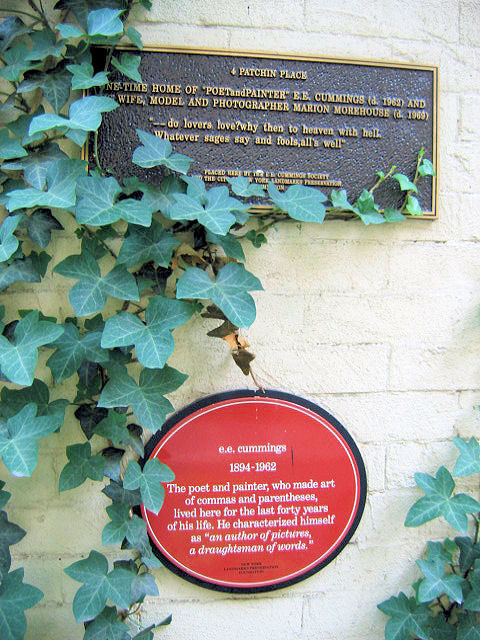Revisited
by Norman Friedman
[Spring 5 (1996): 41-43]
We have written in Spring issues 1 and 4 on the troublesome question of how to type, print, or write the poet's name. It is our considered opinion that he intended his name to be presented with the usual capitals, and that is how some of his publishers have done it—including Norton/Liveright his present publisher. Others, however, have gone forward with the cutesy-pooh notion that, because Cummings is supposedly a "lowercase poet," his name therefore should also be in lowercase. This practice went on even while the poet was still alive, thereby tending to give credence to it.
Although Cummings obviously does not follow conventional usage with regard to caps and lowercase, the oft-repeated notion that he never uses caps is pure nonsense. He uses caps all over the place, but he does not use them in the ordinary way, and that is part of his overall typographical strategy regarding spacing punctuation, and so on, in relation to the various visual effects he created to reinforce meaning.
We will concede that in some of his letters to the Watsons, who were his patrons and friends, he signed his name in lowercase, but that seems to be called for by the personal and intimate relationship he had with them—not to say dependent and childlike, as he counted on them for help and support.
But we will not concede that he intended his name to be in lowercase either for his public or his publications, and we now can bring forth additional evidence as support. We mentioned previously that his customary written signature used the usual caps, letters to the Watsons to the contrary notwithstanding, and we showed samples. We now have even more explicit proof.
As we may have mentioned, due to the kindness of D. Jon Grossman's son, Jerome, we have the complete file of Jon's correspondence with Cummings. On making a preliminary tour through these letters, we found Jon preparing a French edition of his translations of Cummings' poetry, and on 27 February 1951 he wrote to the poet: "are you E.E.Cummings, ee cummings, or what?(so far as the title page is concerned)wd u like title page all in lowercase?"
The poet replied on 1 March 1951: "E.E.Cummings, unless your printer prefers E. E. Cummings/ titlepage up to you;but may it not be tricksy svp[.]"
That seems definitive to us: may it not be tricksy!
For a poet who took such pains with typography as part of his poetic technique, the styling of his name cannot be an indifferent matter. It may not be that a poet can control his publisher's decisions concerning title page and lettering on the binding—I know to my sorrow that I could not do so when my books on Cummings were published—but it is certainly the case that Cummings was just short of obsessive when it came to proofreading the galleys of his own writings inside of their covers and title pages. That the popular image has it that he is a "lowercase poet" certainly cannot be a reason, for he was also obsessive about not being reduced or stereotyped or sloganized by "mostpeople."
However, we are now confronting an entirely new and different way in which this issue has emerged to bedevil his memory. In 1995 we applied to the owner of the building containing 4 Patchin Place in New York City, Cummings' and Marion's longtime residence, for permission to put up a plaque on the wall outside the apartment as a memorial. Naturally, we intended to print his name with the proper caps. We received permission from the owner and then from the legal civic authority, as the building is in a designated historic area.
As we proceeded with our plan to have a bronze plaque engraved and installed, however, we noticed one day that someone else had already installed a plaque—this one of terra cotta—and that it put the poet's name in lowercase. Inquiries revealed that the owner and the civic authority had unintentionally given permission for the installation of both plaques. We tried for months to arrange for the removal of that plaque and for the opportunity to replace it with a bronze plaque with the proper lettering, but we did not succeed. We therefore had our plaque (the upper one of the two plaques shown in this photograph) installed on October 13, 1996.

The cost was $228 for the plaque and shipping, $100 for installation labor, and $16.75 for materials, totaling $344.75. As we paid for this project out of our own pockets, we would greatly appreciate it if you, our readers, would help defray the cost (send checks to Friedman, please).
Texts of the two plaques:
Upper (uppercase EEC):
4 PATCHIN PLACE
ONE-TIME HOME OF "POETandPAINTER" E. E. CUMMINGS (d. 1962) AND
HIS WIFE, MODEL AND PHOTOGRAPHER MARION MOREHOUSE (d. 1969)
"--do lovers love?why then to heaven with hell
Whatever sages say and fools;all's well"
Lower (lowercase eec):
e.e. cummings
1894-1962
The poet and painter, who made art
of commas and parentheses,
lived here for the last forty years
of his life. He characterized himself
as "an author of pictures,
a draughtsman of words."
end-note: Cartoon by Rich
Tennant
reproduced from PageMaker6for WindowsforDammies, 2nd Edition (IDG
Books Worldwide, 1995). By permission of Rich Tennant, who can be
reached
via e-mail at the5wave@tiac.net.
Back to:
Contents Issue 5